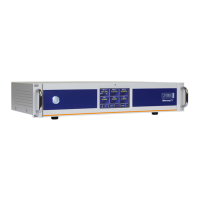MercuryiTC
©2014 Oxford Instruments Omicron NanoScience. All rights reserved.
Page 16
2.6 Optional cooling circuit control
The system can be configured using an open-loop cooling system. Temperature control is then
performed using the heater only.
Improved stability can be obtained if the flow of cooling fluid is also controlled by the iTC. An
optional auxiliary I/O board contains drive circuitry for a stepper motor. This can drive the
opening and closing of a needle-valve, which can control the flow of a suitable fluid. This
function is referred to as “gas control” in the GUI.
Controlling the gas-flow regulates the cooling power, which provides control of the sample
temperature. When the gas control is set to AUTO mode, the position of the needle valve is
automatically controlled to provide variable cooling power. In conjunction with the heater, this
enables accurate temperature control at cryogenic temperatures.
There are two possible configurations. The flow dynamics of these two arrangements are
different.
• Automatic needle valve: the needle-valve is fitted to the main cryostat and controls the flow
between the cryogen reservoir and a variable-temperature insert.
• Automatic gas flow siphon: the needle valve is fitted in an automated gas-flow siphon, linking
the cryostat to a separate cryogen storage-vessel.
In the previous generation of Oxford Instruments temperature controllers, the position of the
needle valve was controlled by a function that operated relative to the present valve position
rather than to an absolute position. The output of the control function was related to the valve
position by a Valve Gearing parameter that defined how many steps of the stepper motor were
present between the valve fully-open and the valve fully-closed positions.
The current release of Mercury firmware allows real-time tracking of the needle valve position.
Rather than update its state at the end of an open/close action, it does so as the valve moves
along. This results in faster response time, more accuracy, and removes synchronization
issues, since the reading is absolute. Now, only mechanical faults will result in losing track of
the motor position.

